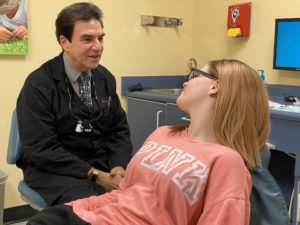
Tooth Extraction Cost Without Insurance
There are several reasons why you kid will need a tooth extraction: extensive decay, loosening due to trauma or gum disease, chipping, and wisdom tooth impaction to name a few.
For individuals who require tooth extraction but are not enrolled or don’t have any dental insurance plans, it can be quite difficult to accept how much the procedure entails.
In such a case, it is best to talk with your dentist first to see if you can work out a suitable payment plan for your budget.
Types of Tooth Extraction and Their Cost
Tooth extraction can be quite expensive, and some families aren’t prepared to shoulder the cost without insurance coverage. However, the need for this procedure can sometimes pop up at the time you least expect it, so you need to be aware of how much you will possibly need. To help you with that, here are the types of tooth extraction and the typical price for each.
1. Simple Extraction (Non-Surgical)
Permanent teeth that are already loose due to trauma or gum disease are easy to extract, and therefore do not require surgical removal. The same goes for baby teeth that needs to be removed to give way for the erupting permanent counterpart. In these cases, all your dentist has to do is to further loosen the tooth from its socket until it pops out, then pick it up with a forceps. Since simple extractions like these are easy and straightforward, they are the cheapest at $75–$300 per tooth.
2. Complicated/Difficult Extraction (Surgical)
This type of extraction is for more difficult cases, like teeth with extensive decay wherein the remaining tooth structure is not enough for the dentist to get a good grip using the forceps. In situations like this, the tooth may need to be split into two or some bone around it may need to be reduced. Simply put, complicated extraction involves additional steps to get the tooth out. This makes it more expensive than simple extraction at $150–$650 per tooth. Take note that this figure will increase if your kid needs more local anesthesia, nitrous oxide, or sedatives to reduce the pain.
Teeth that are partially-impacted by gum tissue and/or some bone also fall under the category of complicated extraction. Without insurance, the average price is around $334.
3. Odontectomy (Wisdom Tooth Surgery)
Impacted wisdom teeth, particularly the fully-impacted and angulated ones, can cause issues with your kid’s oral health. If left untreated, they can cause pain, discomfort, and even infection. If you suspect that your kid has an impacted wisdom tooth, consultation with a dentist to have an x-ray taken is suggested. If your kid’s wisdom teeth are indeed impacted, having them removed costs anywhere from $225–$600 per tooth, or $1,000–$3,000 if you wish to get rid of all four at once.
Again, have you kid’s wisdom teeth evaluated at the earliest sign of discomfort or if you think that they need to be removed.

Preparing for Tooth Extraction
Prior to extraction, your dentist will take an x-ray of your kid’s teeth. This x-ray may either be that small x-ray called periapical x-ray that captures only one or two teeth or the bigger one called the panoramic x-ray that captures all upper and lower teeth, including the jaw and surrounding structures. X-rays help your dentist assess the case thoroughly before proceeding with the treatment. Among the information obtained through x-rays include:
- The anatomy and configuration of the tooth root, to ensure that no other structures will be damaged as the tooth is pulled out.
- The condition of the tooth as a whole.
- The absolute necessity of removing the tooth, and if other treatment options or methods are feasible.
- The most appropriate method of extraction based on the tooth’s location and position.
- The presence of abnormalities or pathologies around the root area (i.e. abscess).
In addition, it is also important to accurately disclose your kid’s medical history, so your dentist can take the necessary precautions and/or make some referrals prior to extraction. Important information that you must disclose include current illnesses, immune status, history of allergies, and medications or supplements being taken.
Moreover, make sure to follow the instructions given by your dentist in preparation for your kid’s extraction appointment. If the appointment is for wisdom tooth extraction, most dentists would advise not consuming any food or drinks for at least 8 hours prior to the procedure.
What To Expect During Tooth Extraction
Before starting tooth extraction, your dentist will again explain the procedure in detail. He or she will then administer anesthesia to numb the tooth and the surrounding tissues.
If your kid’s case is a simple extraction case, a dentist can perform the extraction using just local anesthetics. If the case is complicated and requires surgery, such as wisdom tooth removal, the additional use of sedatives given intravenously may be necessary.
Once the tooth has been pulled out, the healing process begins right away. It will occur like this:
- Clot formation occurs within the next 24 hours.
- Swelling will begin to subside after 2 to 3 days.
- Stitches will begin to dissolve after a week, and any remaining stitches will be removed by the dentist.
- Swelling should completely go away 10 days after the operation.
- Bruising should completely go away 2 weeks after the operation.
If your kid complains of severe, persistent pain or discomfort, or if you think the extraction site doesn’t seem to be healing well, consult your dentist immediately.
What to Expect After Tooth Extraction
Pain, discomfort, swelling, and some bleeding are the most common postoperative complications of tooth extraction. To combat, or at least minimize these, your dentist will prescribe medications. These complications must last only for the first two or three days, then go away on their own after a few days or so.
Below are some helpful tips to help your kid deal with the postoperative complications of tooth extraction:
- Pain and discomfort are common and could last for a few hours. Make sure to give your kid the medications prescribed by the dentist.
- Bleeding during the first 24-48 hours is normal. To stop the bleeding, your dentist will put a small piece of gauze on the extraction site and ask your kid to bite down on it for at least 30 minutes. Biting keeps the gauze in place, enabling it to absorb the bleed from the socket. If the bleeding doesn’t stop and the gauze is already soaked in blood and saliva, simply replace it with another one. Do it every hour or so until the bleeding stops, but never let your kid go to sleep with a gauze in his or her mouth.
- Dry socket is a complication that results from the inability to form a proper clot. To avoid this, tell your kid to avoid spitting or drinking from a straw for the first 24 hours.
- Swelling is greatest during the first 72 hours following tooth extraction. It can be reduced by taking the anti-inflammatory medications, and also by using cold compress intermittently for 10 minutes.
- Strenuous physical activity must be avoided for the first few days. Tell your kid to rest especially in the first 24 hours to ensure a proper and healthy healing process.
- Oral hygiene must be maintained to avoid infection of the extraction site, but tell your kid to avoid vigorous rinsing and brushing the extraction site, as doing so may dislodge the clot. After 24 hours, rinsing is okay and using warm saline solution is recommended. Warm saline rinse not only cleans the extraction side, but also disinfects it and helps expedite healing.
- Diet after tooth extraction must include soft, cold foods and beverages. Your kid must refrain from eating anything until the numbness is gone. For the first 24 hours, hot foods and drinks must also be avoided to prevent bleeding and irritation of the extraction site. Also, no solid foods are allowed for at least 48 hours. Soft foods like mashed potatoes, soup, jello, and yogurt may be given. Solid foods may be added once the area is showing signs of good healing, but you should ask your kid to chew on the opposite side for the meantime.
- Last but not the least, when lying down, make sure that the head is slightly elevated. More bleeding will occur if your kid lies down in a completely flat position.
Looking for a dentist that performs tooth extraction procedures? Find a Kool Smiles partner dentist near you!

